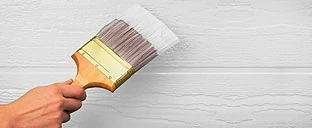DIY home improvement can be hard and time-consuming work. Priming a surface before applying paint offers a host of benefits like a truer paint color, stain- and odor-blocking and time and money savings from reducing the number of top coats. Here are tips that will take the guess-work out of priming and painting:
Prime every time: Starting with a good base coat/primer ensures the truest color for your top coat, no matter the surface you’re working with—walls, cabinetry or trim. Beyond the truer color, primer will also provide a more enduring top-coat finish, extending the longevity of your final paint job.
Choices, choices: Primers typically come in oil- or latex-based forms. Oil-based primers help block tannin or extractive bleeding in certain types of wood. They penetrate deeper into lumber and bond to the wood surfaces efficiently and effectively. Oil-based primers are highly effective in promoting adhesion on new, smooth, “mill-glazed” lumber. The latex-based primers are generally easier to use and remain flexible over a longer period of time. They resist cracking, peeling and blistering, and can be easily cleaned with soap and water. Latex-based primers typically release fewer odors during application.
Execution is key: Don’t rush; take your time to ensure professional looking results. Measure room dimensions twice, cover furniture and other valuables with plastic and then begin priming. A dead giveaway to a professional paint job is how well the paint has covered, and this is dramatically enhanced when you start with a primed surface.
Working with stains: Standard paint is no match for water stains. Always use a stain-blocking primer before applying quality top-coat paint. Check for moisture on the wall by searching for peeling paint, holes or rotted windows or door sills. For lighter water stains, first remove any mold with a specialized mold and mildew cleaning product. Then apply a water-based primer to seal the stain. Follow these steps for a smoother, more consistent paint surface.
Mistakes can be fixed: Don’t panic if you make a mistake or need to reverse an unwanted color scheme. Simply apply a coat of primer and you’ll be working with a clean slate in no time.
Editor’s Note: Barbara Hershfelt is senior product manager for Masterchem Industries, LLC. For more information on priming basics and essentials, please visit www.kilz.com or call 1-866-PRIMER-1.



